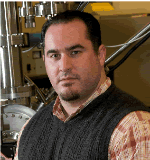
February 26th Colloquium
Colloquium
Department of Physics & Astronomy,
University of Maine, Orono
Robert Meulenberg
Associate Professor of Physics
Department of Physics and Astronomy/Laboratory for Surface Science and Technology
University of Maine
will speak on
“Unusual Magnetic and Optical Properties of Nanostructures”
Abstract: The study of colloidal semiconductor quantum dots (QDs) has been an active field of research for over 20 years. In this time, much effort has been devoted towards understanding the optical properties as a function of nanocrystal size, results that can be explained in terms of quantum confinement effects. Beyond the fantastic size-dependent optical and electronic properties of these materials, exploiting new nano-scale magnetic behavior opens the possibility for an extended range of technological applications. Recently, investigations towards analyzing magnetism in otherwise nonmagnetic materials have been reported for a number of nanoscale systems and are the subject of substantial and ongoing research efforts. Significantly, conflicting origins are proposed in the literature for the magnetic behavior exhibited by a range of nanocrystals, which include the presence of dangling bonds on their surfaces, an intrinsic property only present at the nanoscale and an effect of ligands used to passivate the nanostructured material. In this presentation, I will focus on two technical topics: (1) our efforts towards investigating the control of ligand exchange processes and (2) x-ray absorption spectroscopy studies to understand the effects of chemical doping in CdSe QDs. Most notably, we focus on the trioctylphosphine oxide coated CdSe system with efforts towards exchanging phosphine oxide derivatives onto the QD surface. Intriguingly is the observation of “magnetism” in undoped CdSe simply by changing the surface ligand and particle size. Our recent work focuses around control of the “magnetic” behavior of the nanocrystals via controlled ligand exchange. Using a combination of nuclear magnetic resonance, infrared spectroscopy, and thermogravimetric analysis, we probe the extent of ligand exchange of a function of incoming ligand concentration and QD particle size. We also discuss the effects of multiple washing of the QDs during the cleaning process – QD materials that still possess quantum confinement like features, yet are not dispersible in typical organic solvent. Titrations of ligands from the excessively cleaned materials lead to dispersed QDs. During the course of these measurements, we will discuss the impact these surface chemistry treatments have on the photoluminescence of these materials. In examining doped QDs, both x-ray absorption near edge structure spectroscopy (XANES), ultra-violet x-ray spectroscopy, and theoretical modeling are used to examine effects of hybridization on the band edges in doped CdSe QDs. In the case of Cu doping, while UPS suggest that the scaling of the valence band states follows quantum confinement (QC) theory, Cd M3-edge XANES provides evidence for a lowering of the conduction band minimum (CBM), a result inconsistent with QC theory. Theoretical modeling suggests the effects of hybridization between Cu and Cd atoms in the QD can explain our experimental results. The hybridization effect leads to both active emissive states below the CBM resulting in tunable near-infrared photoluminescence as well as an increase in the electrical conductivity of the doped QD solids. Our work shows that simple chemical models can provide predictive tools towards probing the effects of chemical doping in QDs.
Friday, February 26, 2016
3:15 pm
Bennett Hall, Rm. 140
Refreshments will be served at 3:00 pm
